Flashevap.com
— Viip Development Page —
NOTE: May 17, 2014 — Here is a listing of the vaporizer
models I have built and sold over the years: First there was the
Flash Evaporator which I built in the mid 1990s, I think
it was. Around then there was also the Omega Ultra Light,
which was my cleverest non-portable air-heater unit, used with a soldering gun.
Then came the Eterra, about 15 years ago. Around
2005 came the Pneuma. Then I built a
New Flash Evaporator, based on the Pneuma
design. Finally, there was the Tobacco Master, and the
Viip portable, described below, which I was building as a custom unit but decided
not to sell because of the battery's liability risk.
June 2, 2013 — Viip's Bloated Setback
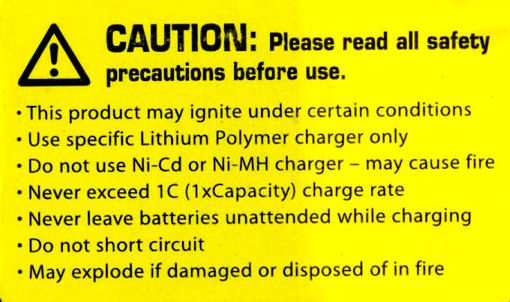
These lithium batteries: They're amazing sources of high-power
energy. But there are risks, which Boeing found out with its 787
Dreamliner batteries. Here's what happened to the
ViiP's 3-cell battery:
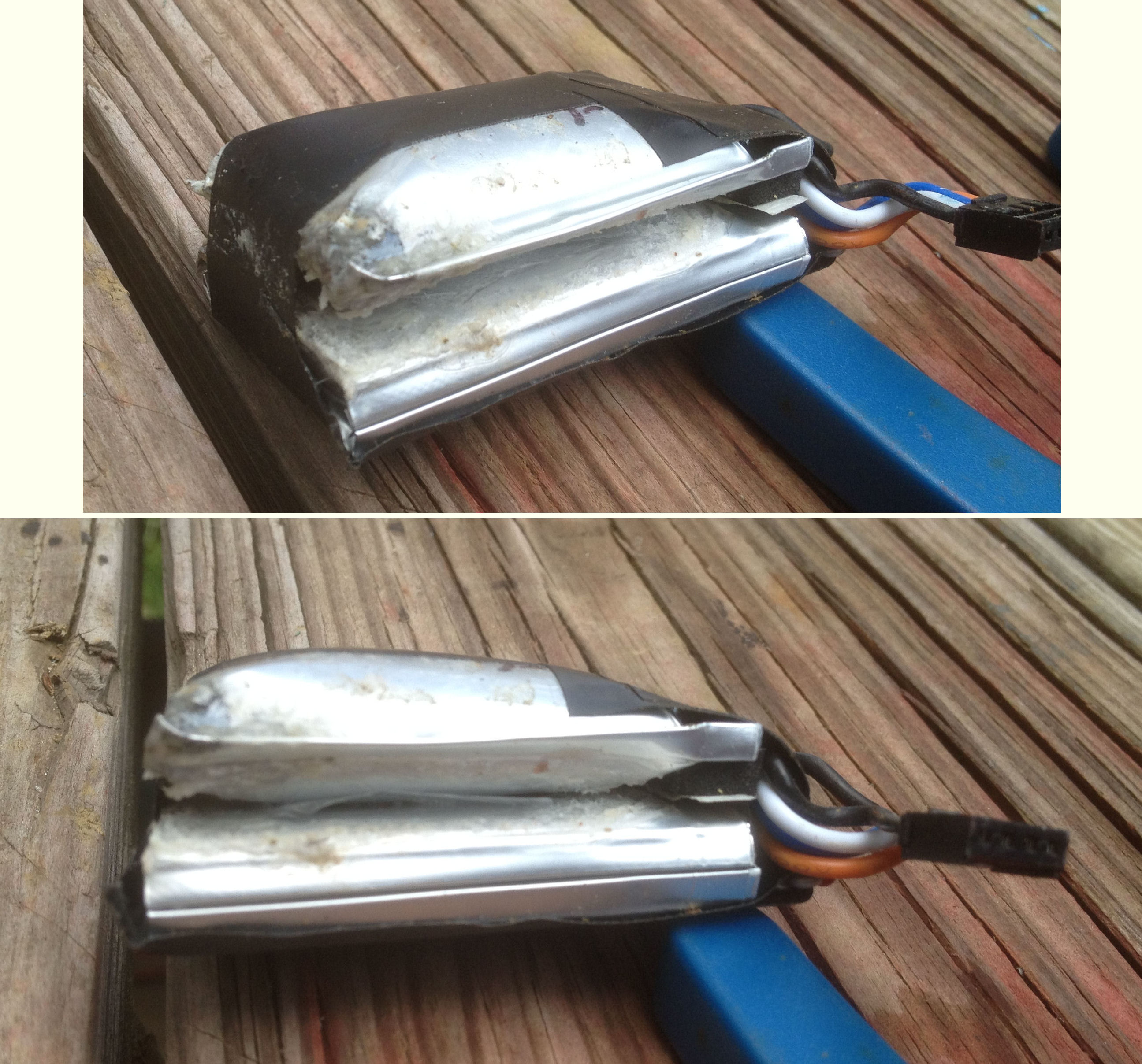
I had called the customer who was buying this unit to tell her she
could pick it up next time she was in town. Then, on a Friday evening, I charged up the battery,
but got a funny warning from the charger; one cell was over-charged. I opened that case and took
the guts out, which include the battery and set it on the workbench. By Sunday, the battery looked
as above. It would have wrecked the whole thing, had this happened inside the brass case.
Luck was with me — and agin me.
Lithium batteries have been questionable to me, even before the
Dreamliner lithium-battery fire. That "Caution" note above, it's on every battery; the batteries
of several years ago came with a sheet of scary handling instructions which included lines like,
"Good to have a concrete driveway or slab handy, to throw the battery onto if bad stuff happens."
Instructions that come with the chargers say that you should never leave the battery alone when
it's being charged.
The ViiP itself, it works great, but I had been drafting an
official-looking document for the customer to sign, saying she had been fully informed of the
battery-related risks, but would it have limited my liability had it burned down her new house
in San Francisco? A friend pointed out that, given the illegal nature of ViiP's use, I'd
probably be okay if something bad happened. But who wants to test that sort of thing? Back in
the 1970s, I did a lot of expert witnessing, and I saw how even if the plaintiff had no case,
the defendant is still faced with legal expenses and hassle.
So, I decided not to sell it to the customer, who was to pay a
record high price for one of my creations.
ViiP's on hold for now — except for my personal use, of course.
In the meantime, I'm going back to random science experiments and attempts at creative
non-fiction writing. My next report will be on a laser microscope I'm trying to build. Or
another laser-based recap of Thomas Young's 1805 experiment.
Or something . . .
April 10, 2013 — First Commercial ViiP III Progress Report
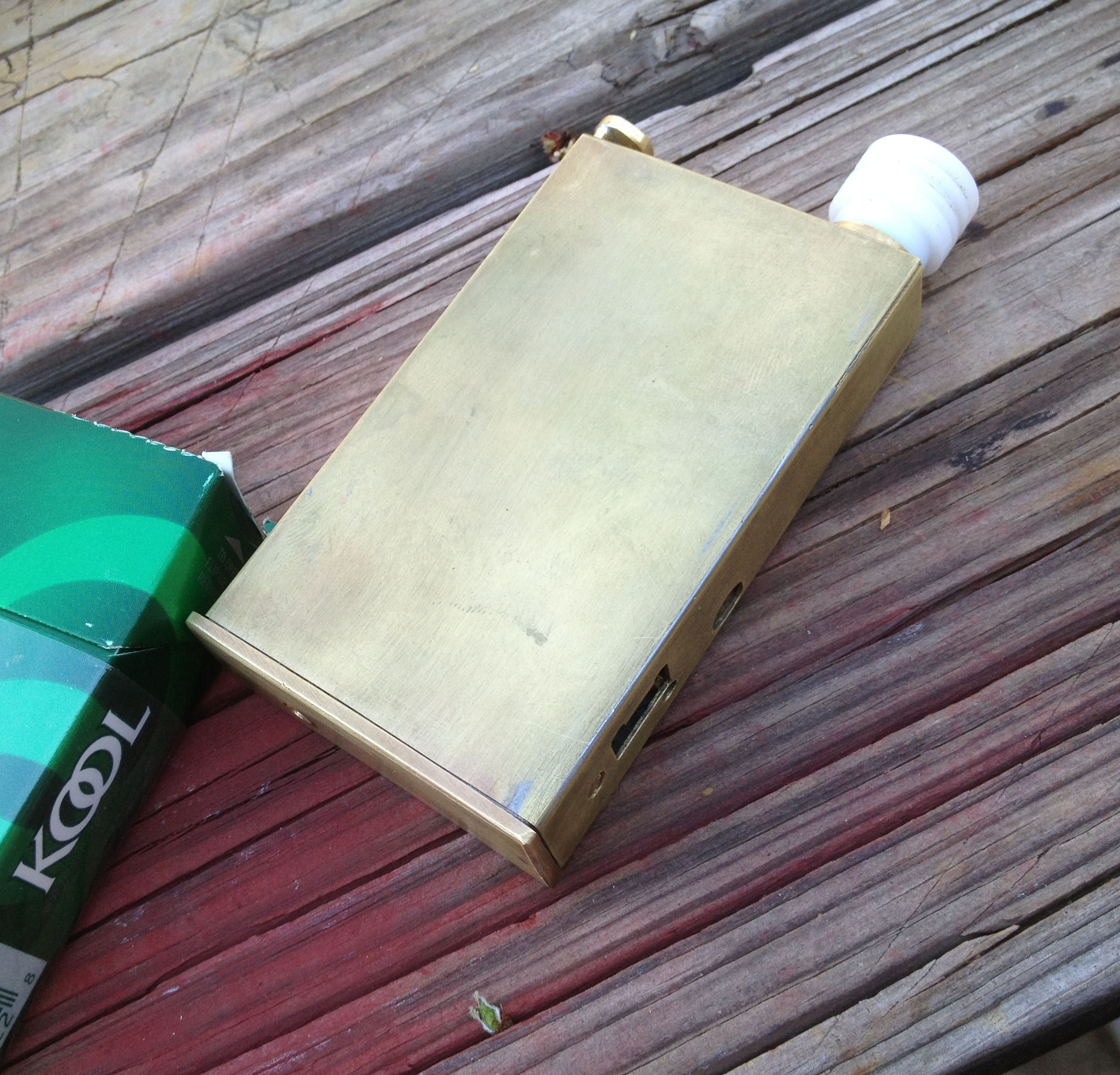
The ViiP III (above) that I've been struggling with for much of
this winter — it's for a customer, you might recall — is finished . . . except for a little polishing.
Note in the photo the charging port and light-indicator port. It's smaller than a standard pack of
cigarette. Here it is in the box:
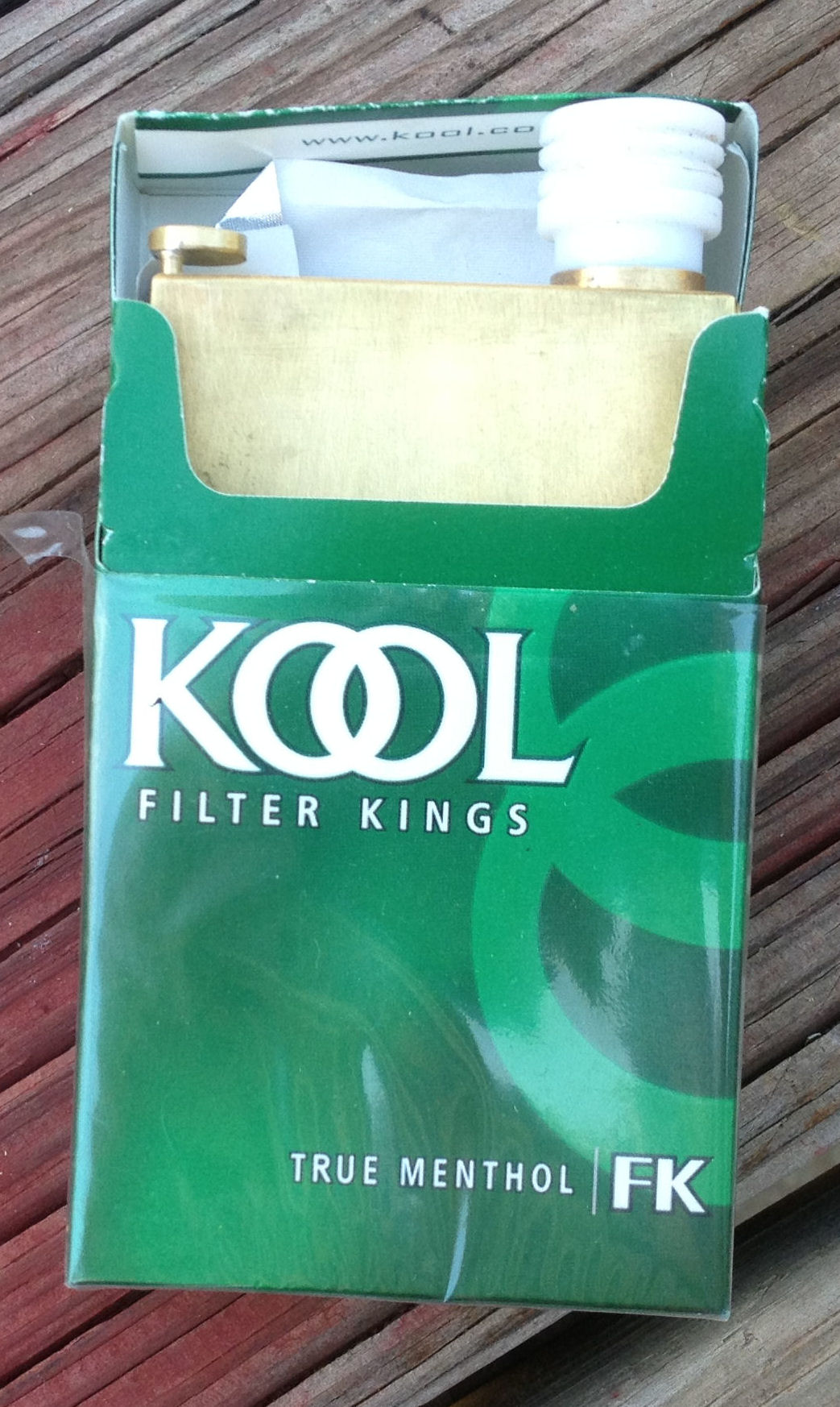
Were this ViiP only 2-cm shorter, the box could be closed and
used as a kind of stealth carrier. We're working on that . . .
I'd like to show the innards look like, but the patent advisor says
to wait, for the time being, because it contains several new ideas, such as the controls, which are
unexposed to the outside world, so that it can't be turned ON accidentally.
It works great, by the way. And it's amazing how many times I can use
it before recharging it: about five days between recharges. The next ViiP III will have a
low-battery warning indicator — in the form of a flashing light or a vibrator feature. And it will
be at least a centimeter shorter than the one above.
March 5, 2013 — ViiP label, Recharge Plug, Progress Report
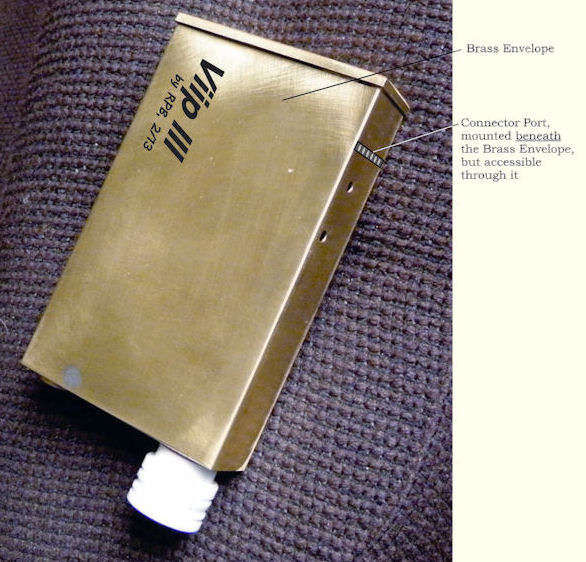
The photo shows the latest "study" model of the. The logo is a paste-up
job, and so, too, the battery recharge plug. The plan was to make only one 'study model' before
finalizing the customer's unit. Four 'study models' have been built so far. One idea leads to another,
and each time it gets better. But at some point, soon, the customer's ViiP III WILL HAVE
TO BE COMPLETED! By the end of this month would be good, but . . . we will see . . . Such is the
nature of this inventing business.
Molex connectors were ordered today. And yesterday I realized that the
temperature-control circuit can be made with the new surface-mount method, and it might require, spacewise,
less than one-tenth the volume of the current through-hole temp-control circuit.
I've also learned a few things about laser engraving of metals:
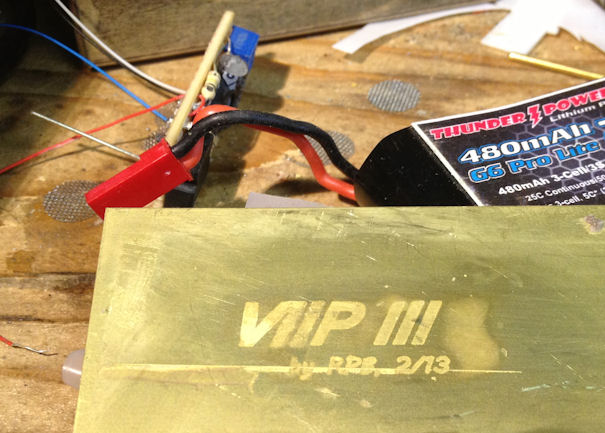
Here's an acid-etch engraving, sort of. It came about this way: A friend
mentioned that he had a laser engraving machine, a ~$20,000 unit that he got cheap, just to fool with.
(He got a good price, but . . . it's nice to know well-off people who can fool around that way. He said,
"Yeah, let's try the engraver, but I don't think that a carbon dioxide laser can etch metal." And he was
right: Carbon dioxide lasers produce rather long-wavelength light, on the order of 10,000 nm (nanometers),
which is about 20 times longer than the wavelength of green light. I need to find someone with a green
laser or even an ultraviolet one. In the case of the acid etch above, we found that his carbon dioxide
laser can vaporize Scotch tape, so we used the laser to make a high-resolution mask. Then I tried
chemical etching (hydrochloric acid mixed with iron oxide, to make a paste), and got what's shown there,
after removal of the laser-cut Scotch tape mask. I'm still experimenting with this . . .
January 26, 2013 — ViiP on Mercury, and ViiP III Semi-Progress Report!

The ViiP above is actually the old Tobacco Master #1105 (which is
now officially known as ViiP I). The old guts of the thing have been installed in a new "art"
case provided by Linda, a fan of Flashevap's products and especially of the new ViiP units.
She used polymer clay to make make this
amazing new case for our Old Reliable, now in almost daily use for, what, 6 or 7 years. Time definitely
flies. If you click on the image you will see two other views of this exciting new/old unit sitting on
the latest issue of Science Magazine, which features a special section about the Messenger Vehicle
currently orbiting Mercury.
As for the development of the exciting new ViiP III, it's been
a cold week here in the Washington, D.C., area, which makes things uncomfortable in Flashevap's unheated
laboratory. Actually, the cold just shortens the work cycle to about two hours each day, so despite the
cold, a new and complete brass case is nearing completion, similar to the brass case shown below, but better.
Photos will be posted soon, depending on the weather, and a return of the global warming we're getting
used to here.
Elsewhere in the news of this week, Flashevap's full-time beta tester, Dave, has
inadvertently determined the lowest serviceable battery voltage, below which the unit simply will not work.
We're still trying to determine the full meaning of this new datum point. Also, one of the batteries,
possibly the one involved in the 'melt down' of January 4 (sdee below), has utterly failed, luckily without
a fire of the sort that happened this past week with lithium batteries in Boeing's
787
Dreamliner. (Wikipedia says
the Dreamliners cost nearly a quarter of a billion dollars each — and people complain about the prices I
charge for these state-of-the-art portable vaporizers.) Whew! Onward we go . . .
January 15, 2013 — ViiP IS IT! — The New Name for the former Tobacco Master
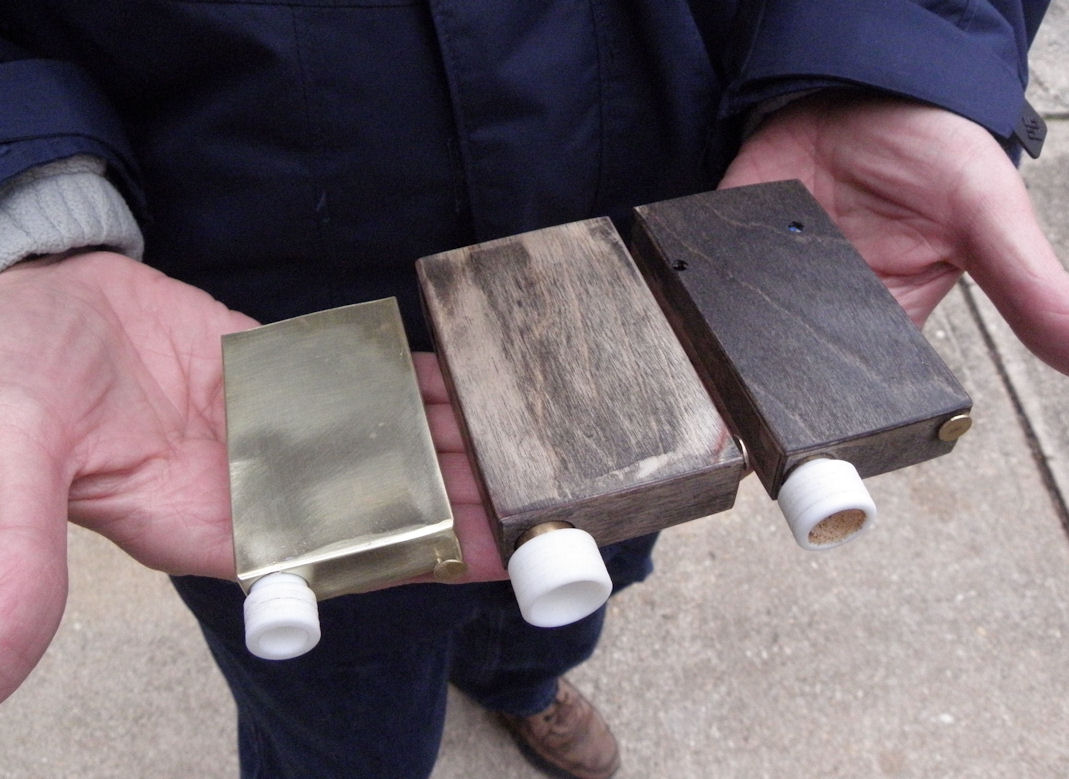
A new name has been selected, ViiP, and there's the
almost-completed and already working new model on the left. More specifically, it is the ViiP III.
(The unit in the middle, which is about a month old, could be called the ViiP II.) On the
right is the old reliable Tobacco Master #1105, which refers to November 2005 when it was
built — and from which date it has operated flawlessly using the original battery — except for a few days after
I dropped it onto a concrete sidewalk in NYC. Here's an earlier
view of TM#1105, back when I was abandoning the vaporizer business:
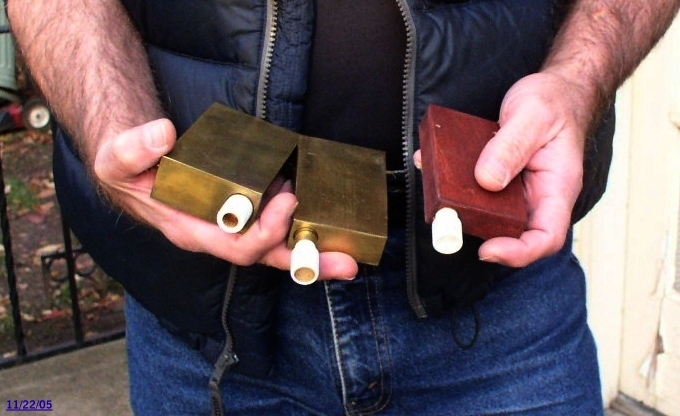
That's Old Reliable TM #1105 on the right, in the dark-stained wood housing.
Note the earlier brass Tobacco Masters to the left, #505 and #705, which were truly massive, though they seemed
wonderfully compact to Dennis and me at the time. The ViiP III is the most compact yet, measuring
only 8 cm long by 5 cm wide and 1.5 cm thick (not counting the white "stem" or little little "tamper/pick" opposite
the stem). In inches, that's 3.1 by 1.9 by 5/8. I'd show a view of the guts of this baby, but I don't want to
reveal several design ideas on which I might file patent applications — such as the internal controls, which
are operated remotely so that there's no chance of accidental turn ON or of it being left on when not in use.
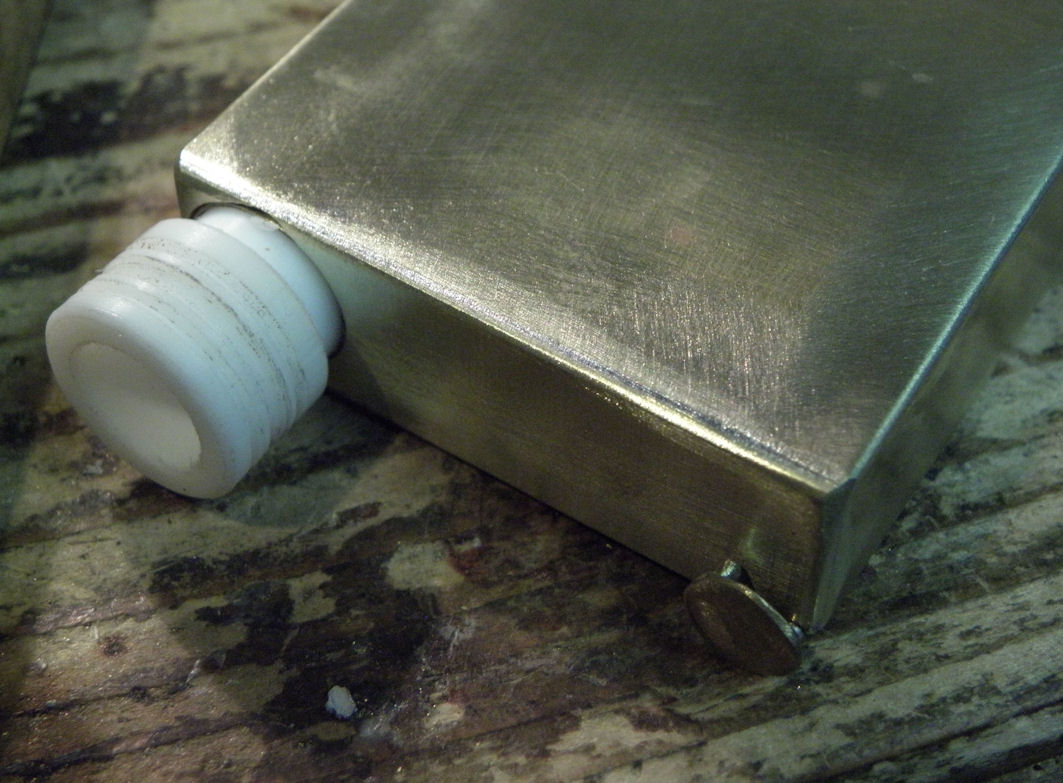 Here's a close-up view of the new brass case. (Click on the image for
a larger view.) The earlier brass cases of 2005 were made of soldered brass panels, which had sharp edges
that were uncomfortable to hold. This new case has rounded edges made by bending the metal over a mandrel that
a friend made for me. I plan to plate cases like this one with nickel,
silver, or gold, depending. However, for the customer who is now waiting for the first production model of
the ViiP III, I might make the case of pure silver . . . as she is paying quite a lot for it.
(For the record, the ViiP III model shown here is only the "study" for the one the customer will
get; the model in the pictures will be my new personal ViiP III . . . until, that is, I figure
out a way to make make a yet smaller ViiP IV. The customer's ViiP III will be completed
within the next month, depending on how fast I solve two more design problems.) Here's a close-up view of the new brass case. (Click on the image for
a larger view.) The earlier brass cases of 2005 were made of soldered brass panels, which had sharp edges
that were uncomfortable to hold. This new case has rounded edges made by bending the metal over a mandrel that
a friend made for me. I plan to plate cases like this one with nickel,
silver, or gold, depending. However, for the customer who is now waiting for the first production model of
the ViiP III, I might make the case of pure silver . . . as she is paying quite a lot for it.
(For the record, the ViiP III model shown here is only the "study" for the one the customer will
get; the model in the pictures will be my new personal ViiP III . . . until, that is, I figure
out a way to make make a yet smaller ViiP IV. The customer's ViiP III will be completed
within the next month, depending on how fast I solve two more design problems.)
As for the new name, ViiP, many names have been suggested: E.g.,
Mobe (pronounced as one syllable with a long "o") referring to mobility; Free, also suggesting
mobility; Slide, with its slick and sexually suggestive image of freedom; Vippo, which might
already be in use, at least as of 2010 and in reference to, I think, a similar though never realized
portable vaporizing invention; Porta, obviously referring to portability, but not a pretty word.
Vippo brings Zippo to mind, with its glamorous reputation in connection with tobacco and inhalation in
the midst of the thrilling aspects of WWII, Korea, and even Vietnam.
The name that has been chosen — ViiP — came about by way of
Vippo. ViiP rhymes with 'ship.' It is simple to write, easy to remember, the 'v'
refers to vapor and "vi" to life, and the name suggests the power and prestige of a VIP.
Four letters, one short syllable. Brief and sharp.
That's it: ViiP. — Except for the number — say,
ViiP 3, or as I'm using it here, ViiP III — to suggest a specific developmental
model that is part of a sequence of ever improving portable vaporizers . , .
More news to come about ViiP . . .
January 7, 2013 — Names of People and Things

That's Dennis in 1980 when he was 12 years old. The bike and the water rocket,
that was our first project together. The water was pressurized to ~2,000 psi with nitrogen. I was 38 then,
working for an environmental consulting outfit and also doing expert witnessing work in automobile accidents,
consumer-product failure/injuries, and industrial accidents. And in my spare time, I was experimenting with
the vaporizing of tobacco and whatnot.
Dennis lived about a block from each other in a little town beside the
Potomac River, just outside Washington, D.C. My nextdoor neighbor, Reed, who knew everyone in that town, told me
that Dennis was trying to figure out a way to make his bike have better acceleration, and he thought I might
be able to help. So he brought Dennis over and we started work on our first project of many that we did off
and on over a period of 25 years.
We built at least one Tesla Coil together, did chemical experiments
(or so we called them, though it was mostly pyrotechnics and explosions for the fun of it), welded up stuff,
melted metals for various reasons, and occasionally we visited interesting places like the
Sidling Hill Road Cut in central
Maryland — which, for a time, was the deepest roadcut in the world.
 The photo shows five and a half tons of high explosive going off during
the cutting process, probably in 1979 when I discovered the project while driving west to get photos of
coal strip mines in Ohio; I found the chief engineer of the project who gave me copies of his sequence
photos of the work, and he let me get in position to take a series of photos when the explosion went
off — in fact, he gave me control of the explosion: when I waved my arm, off it went. It was like an
enormous sledge hammer hitting the mountain. The photo shows five and a half tons of high explosive going off during
the cutting process, probably in 1979 when I discovered the project while driving west to get photos of
coal strip mines in Ohio; I found the chief engineer of the project who gave me copies of his sequence
photos of the work, and he let me get in position to take a series of photos when the explosion went
off — in fact, he gave me control of the explosion: when I waved my arm, off it went. It was like an
enormous sledge hammer hitting the mountain.
We worked on LED "light sculptures,"
one of which we sold for $1,000 in a local art gallery, plus others for lesser amounts, and Dennis became
an artist for a while.
When the movie Back
to the Future came out, it was natural that we should identify with Marty McFly and "Doc" Brown. It was
that sort of relationship, and some people say I am eccentric in a way that fits my Doc Brown role.
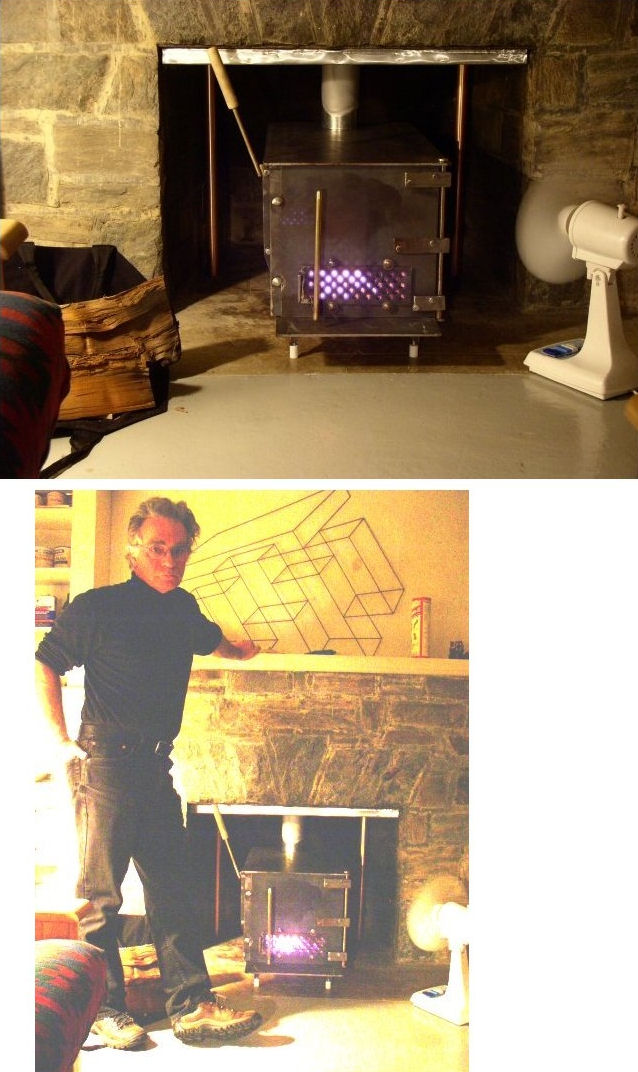 We built a steel wood-burning stove together and considered
how to make woodstoves efficient. From that and other projects, we got insights into heat transfer, insights
that led Dennis push me into building the Tobacco Master, a project on which we
spent many long days working, summer and winter in our unheated "laboratory" between 2002 and 2005. Dennis
was the inspiring force for that project. We built a steel wood-burning stove together and considered
how to make woodstoves efficient. From that and other projects, we got insights into heat transfer, insights
that led Dennis push me into building the Tobacco Master, a project on which we
spent many long days working, summer and winter in our unheated "laboratory" between 2002 and 2005. Dennis
was the inspiring force for that project.
Dennis, who I've indulged in thinking of as my protege, is now 44 and I'll soon
be 71. He is now an engineer and he works as an engineer specializing in battery work, a realm of knowledge that
derived from our work together on the Tobacco Master. He got married several years ago and had a first son,
Jason, who we all hope will become technically oriented, though we won't be disappointed if his interests
lead somewhere else entirely. And now this:

That's Dennis's second son, Kevin Robert, resting peacefully in his mommie's arms.
He was born on December 9, 2012. That second name, Robert, that's after me. Dennis says I'm responsible for
him being what he is today, which makes me feel very good.
Final Note: That photo above, of Dennis blasting off on his water-rocket bike,
it's deceptive. Not only was that our first project together, it was also our first failure: it looked good,
but all it did was squirt water out the back. From that we both got solid a better understanding of momentum
and thrust, and we learned something about the solubility of nitrogen in water at high pressure. And so
it went.
January 4, 2013 — Melt Down!
The lithium-polymer batteries that power the X Unit vaporizers
have worked flawlessly, despite the dire warnings that come with the new batteries about their potential to
catch fire. That still has not happened with these high-power batteries. But on Tuesday, New Year's Day,
I was trying to test my latest model, the smallest, most compact one yet. (I'd show photos, but this
particular model has a new remote-control ON/OFF switch that is effectively impossible to trigger accidently,
and, at least at this moment, I don't want to photograph it because it's such a neat idea that I might
yet apply for a patent.)
Accidental turn ON has been a problem all along; it is a liability problem, a glaring
one that I think about whenever I consider producing and selling these things. The main
ON-switch has usually been a toggle unit from Radio Shack, with the toggle sawed off to make it
difficult to turn ON accidentally. Despite the sawed-off toggles, several times over the years, I've found the
unit turned ON in my shirt pocket or knapsack, because the toggle has been snagged and tripped. If
the air-heater ON button, which is easy to push, had also been accidentally
pressed, the property damage and possible injuries could be extensive. I don't want to reveal, at least not at
this moment, the solution I've come up with, except to say that the switch I needed is not one that can be
purchased; I had to make it myself. And, when I installed it, I didn't check to see that it was operating properly
before I tested the whole machine. Turned out that the home-made, custom switch was grounded out to the brass
framework so that, as soon as the battery was installed, the circuitry underwent a direct short circuit.
I didn't immediately notice the short circuit was happening; I just couldn't figure
out why the system didn't work when I should have — until smoke and the smell of burning circuit board and components
began rising from it.
The battery survived, which I wouldn't have expected. They are rated at a certain
maximum discharge amperage which, if exceeded, I thought would cause damage. The battery seems to have survived,
though it was a tiny bit warm to the touch. The control circuit, however, was pretty much wiped out, especially
the main field-effect transistor that switches on the current to the air-heater
coil.
As Richard Nixon once, observed, "I learned more from my defeats than from my
victories." Who'd've thought wisdom was there?
I rebuilt everything the next day, including my custom switch so that it can't short
out again. Now I'm building a casing for it, metal or leather, and I hope to have a photo of the finished unit
soon, like within a few days . . .
December 28, 2012 — Progress Report
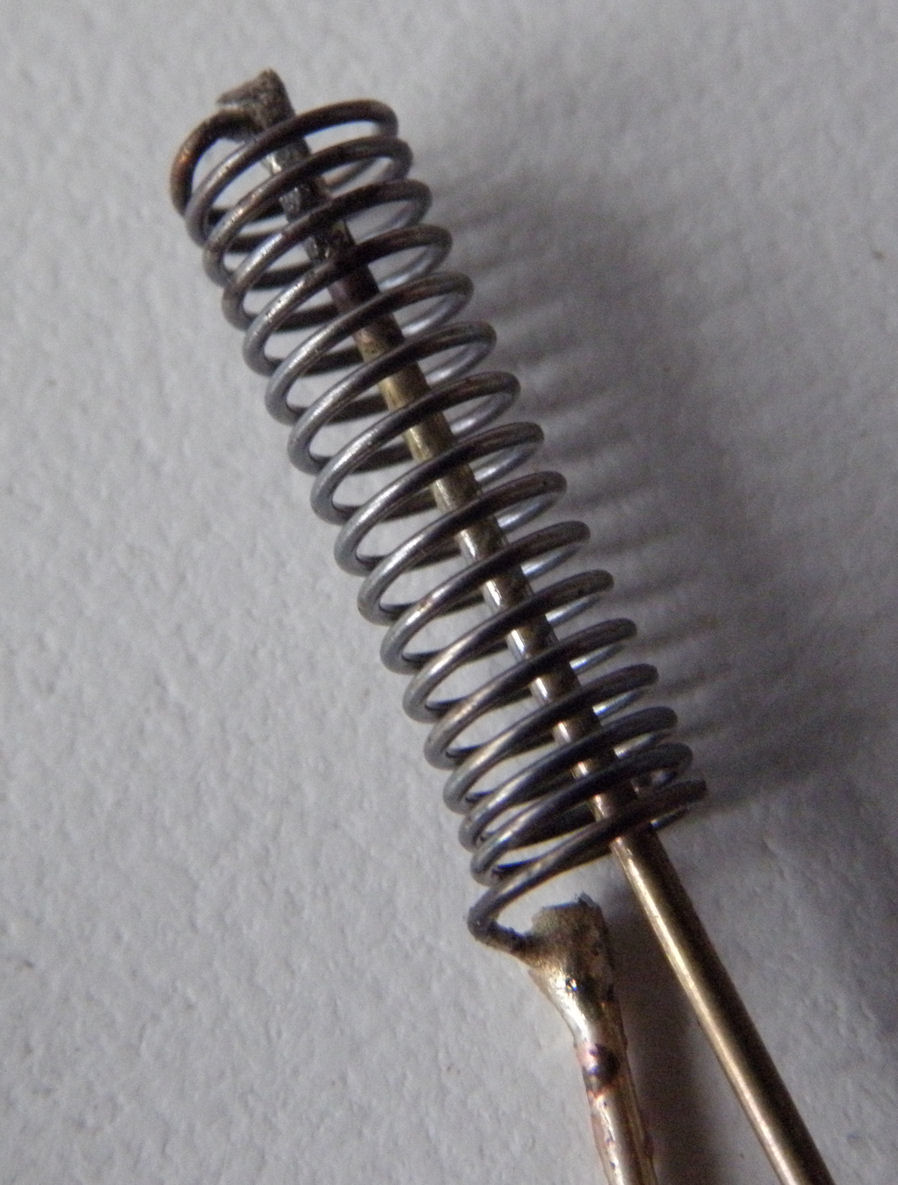
This is a new heating element for one of the several X Units
I'm presently building. It's made of nichrome, on brass supports. It dissipates about 65 watts when turned on
full power. Gets hot fast, in other words, like about half a second, maybe less. Haven't timed it, but it
provides essentially instantaneous heat.
The view below shows a heating element being wound on a lathe.
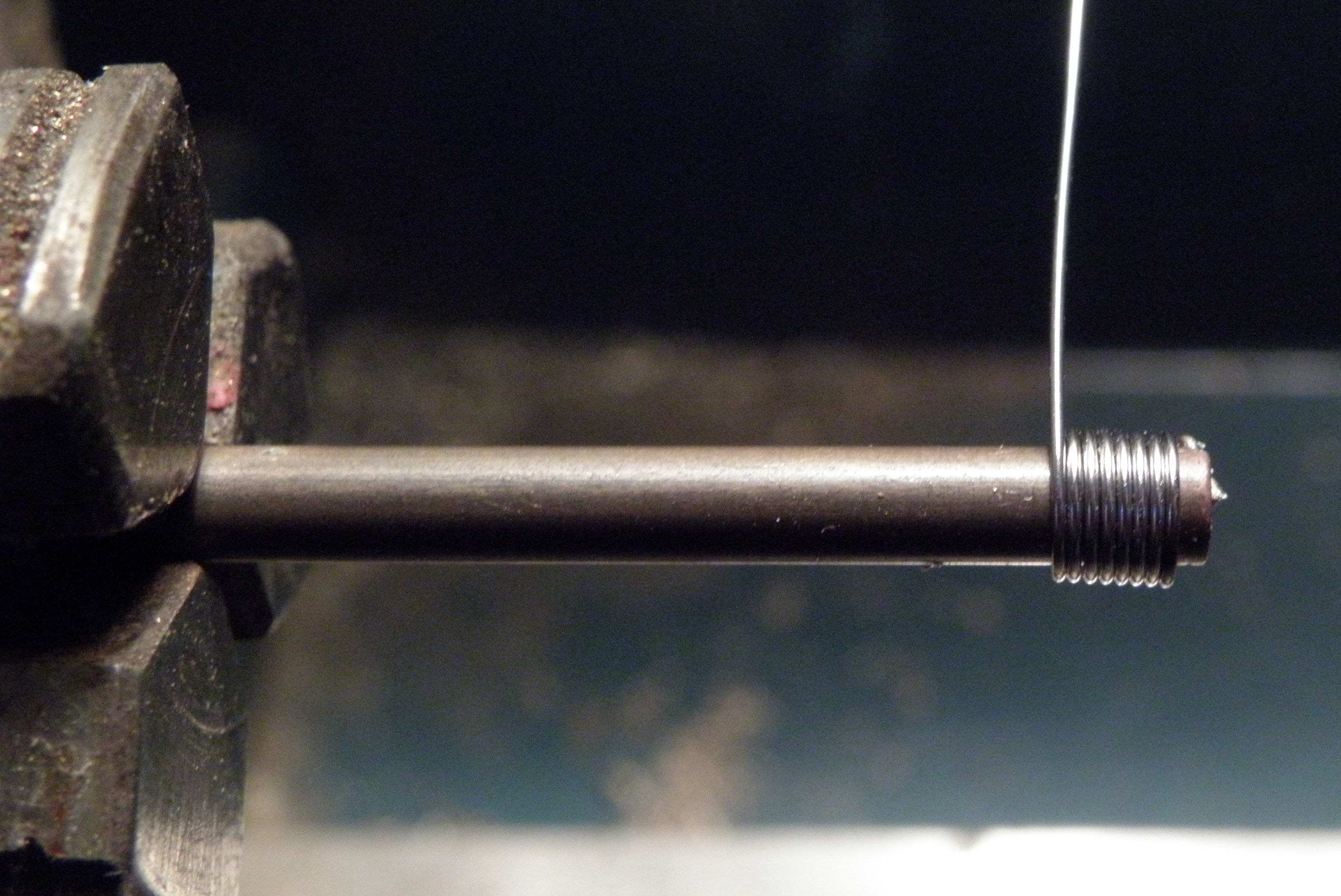
I wind them over a brass mandrel.
Here are three brass air heaters that are in the works. The heating elements, above,
are disposed within the brass air heaters.
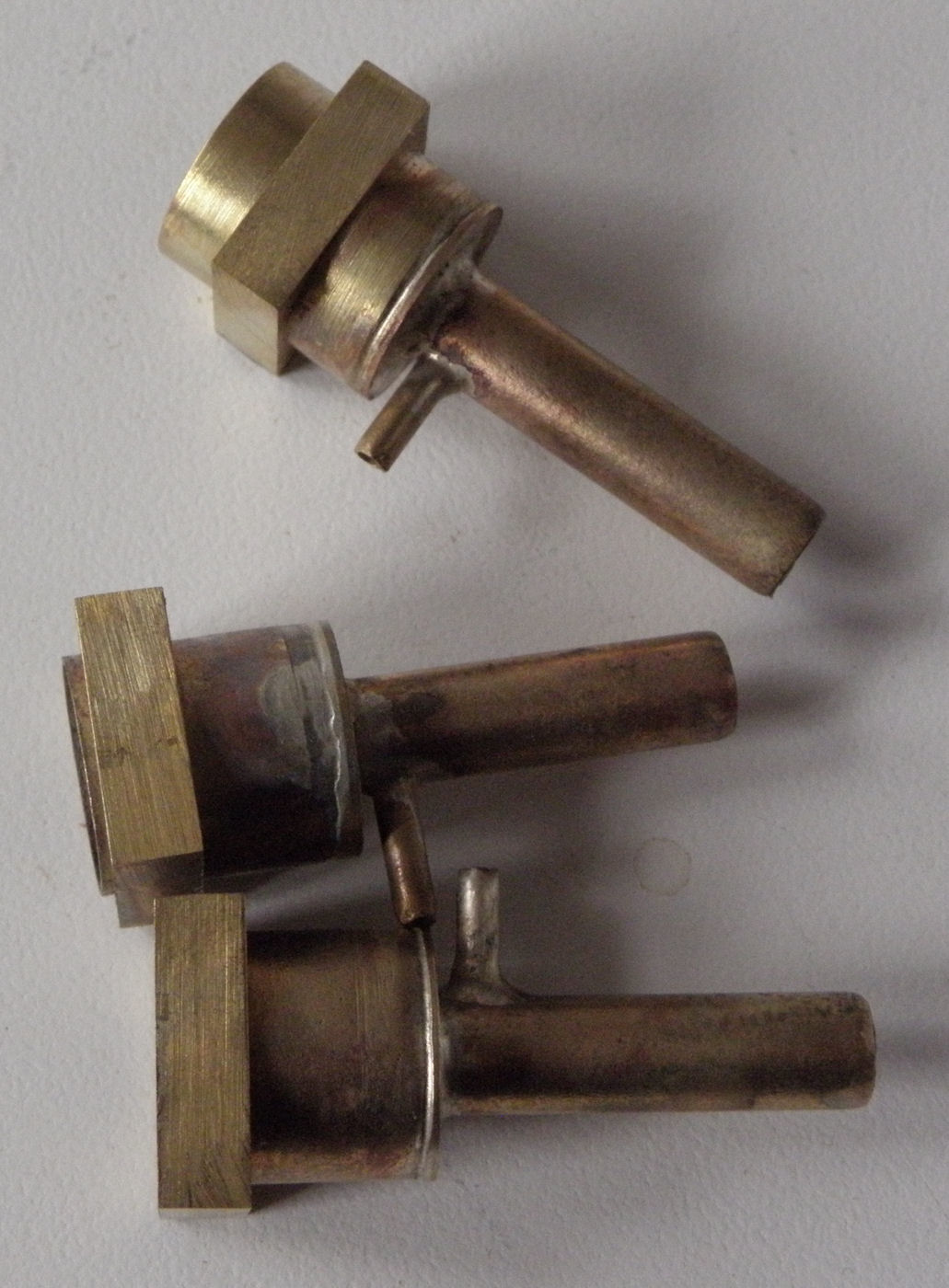
The air heaters are made of brass tubing that has a 0.015" wall thickness. They are
soldered together with silver solder. You can click on the image for a larger view.
As I write this, I have some doubts about how much of this I should reveal.
During the last few years, I've been ambivalent about making vaporizers. The ambivalence is in the form of a
loss of interest and enthusiasm, which used to be abundant years ago when I produced and sold the Flash
Evaporator, Omega Ultra Light (which someone should reintroduce),
the Eterra, and the Pneuma. But now the enthusiasm is returning —
I think and hope. The problem might be age-related, but who knows? Maybe a depression related to this business
of getting old. When I was young — i.e., up to the age of 60 or so — I assumed, or ran my life as if, I was exempt
from aging and mortality. When I restarted this project about six weeks ago, my plan was to reveal everything to
the world. Now, as the mood improves and enthusiasm feels like it's returning, I'm thinking I might want to
protect my intellectural property discoveries. We will see what happens . . .
A proper name for the X Unit is still needed. Wireless has
been suggested. I'll think about it, even if I'd rather stick a single-syllable names. So, too,
Jolt has been suggested, but there's an energy drink having that name — and I don't think my vaporizers
really can be said to give a jolt. Likewise with the recently suggested Shock; it isn't really applicable.
Surprise comes to mind at this moment. Gotta think about that one. It's the name of the ship
in Patrick O'Brian's Master and Commander series.
My immediate focus is on overall size of the unit — I'm trying to make it smaller.
Here's the way the guts of the most recent units have been laid out:
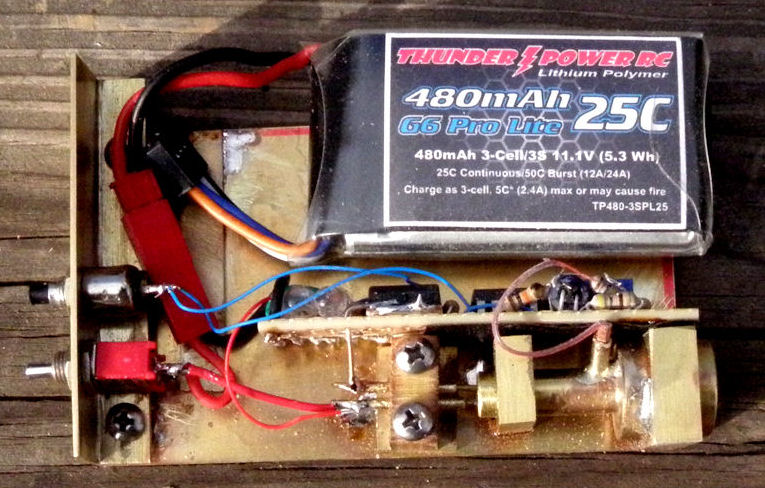
Notice that the electronics that controls the air-heater temperature is located
between the battery and the air heater. (You click on the image and see labels on the parts.) Notice, too,
all the unused space near the control switch and button. If I can move the electrics to the back of the unit,
then the overall width can be reduced by nearly a centimeter (i.e., about 3/8").
In my next posting, I'll show my progress in shrinking its overall size. I also
want to make a nickel-plated casing for it, with sexy controls and indicator lights.
New Business — December 9, 2012
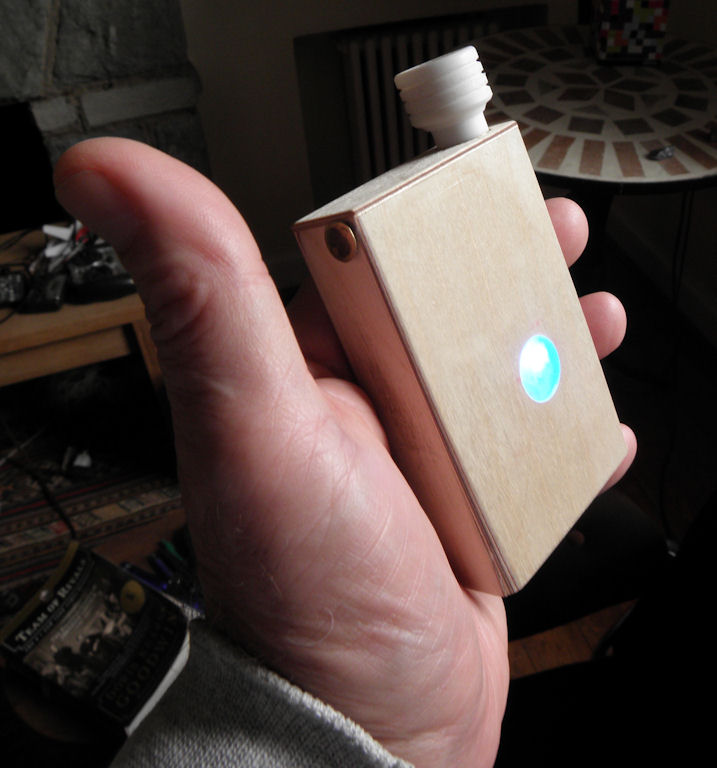
Portable Redux — The X Unit
|
|
That picture shows my current personal portable vaporizer. If you click on the image, you'll see
the guts of the thing, with labels. And there's another view of the guts in this view of a portable
unit that I built for a customer. And here's another view of the unit shown above.
I admit it's not pretty, but that's one of the issued discussed below.
Tobacco Master was the previous name of these units. I
wanted to deflect from the obvious marijuana association. But now a new name is needed, not necessarily referring to
marijuana, but rather just something dynamic, I think, like, for
example, Spark — or, who knows, Flash, though it's likely already a registered trademark for
some product by now. When Dennis and I built the first successful unit four or five years ago, we called it
Hitman, which a Google search shows is no longer available for this purpose. For now, I'll call it simply
X, or the X Unit.
The main challenge is producing and selling these X Units is product liability.
The batteries, for instance — lithium polymer — are very powerful; when you buy them, they are accompanied by a
'horror sheet' that tells about all the ways they can catch fire if you overcharge them or if you discharge them
too far before recharging, and that you should be near them, and ready to get them out of the house fast, while they
are charging. Also, since the batteries I use consist of three cells, each cell has to be monitored
during recharge — which means that the battery has to be removed to be recharged. I have not yet determined how this
multi-cell charging problem is dealt with in other appliances, such as, I think, laptop computers and smart phones
that use these batteries. Therefore, a major design problem is making the cases in a way that allows the battery
to be easily and safely removable by people who are not used to such things.
If you look at that center picture, you'll notice
also that there is much wasted space inside the unit; it could be made smaller in length, though not in width, at
least not with the circuitry disposed between the battery and the air heater. The main power wires will have to be
made smaller and more flexible (though they do carry a lot of current), and the "ON" Switch and Air Heater Button
need to be much smaller. Maybe 15 millimeters of length can be eliminated from the 10-cm current length.
A prettier outer casing is needed — though the the custom job
I did for a customer looks pretty good.
I'm standardizing the design, so as to simplify production — should that ever happen. I'll
be posting detailed photos of development progress over the news few weeks . . .
Send comments to Bob.
NOTE: To repeat: I write the hypertext codes for
this site myself. I tailor it for Firefox so it might look distorted on other
browsers.
As always, thanks for the email.
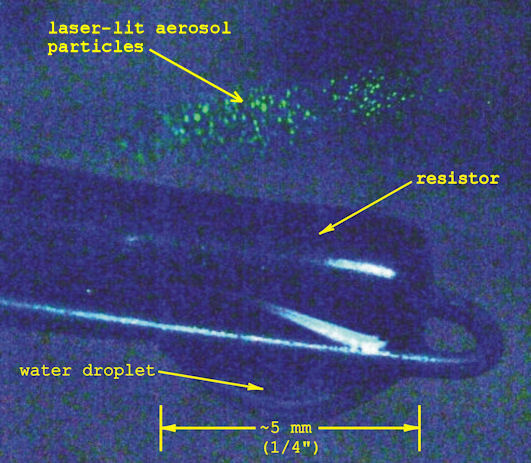 11/04/11 — The little green
dots near the top of the image are particles of what is commonly called
"steam" — i.e., "aerosol particles" which, in this instance, are tiny water droplets rising from water that is boiling off of the hot electrical resistor. This comment is
Seeing Small Things with a Cheap Laser. 11/04/11 — The little green
dots near the top of the image are particles of what is commonly called
"steam" — i.e., "aerosol particles" which, in this instance, are tiny water droplets rising from water that is boiling off of the hot electrical resistor. This comment is
Seeing Small Things with a Cheap Laser.
 11/03/11 — God the Sun — and
The Wealth Argument for a Space Program. 11/03/11 — God the Sun — and
The Wealth Argument for a Space Program.
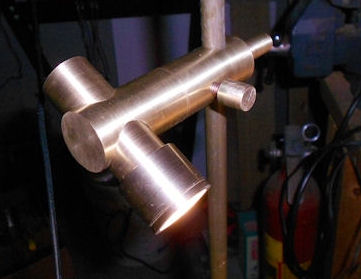 11/01/11 — There are lots of good reading lamps
on the market, even LED ones. Still, I had to make my own Massively
Brass LED Lamp, which came out pretty good. 11/01/11 — There are lots of good reading lamps
on the market, even LED ones. Still, I had to make my own Massively
Brass LED Lamp, which came out pretty good.
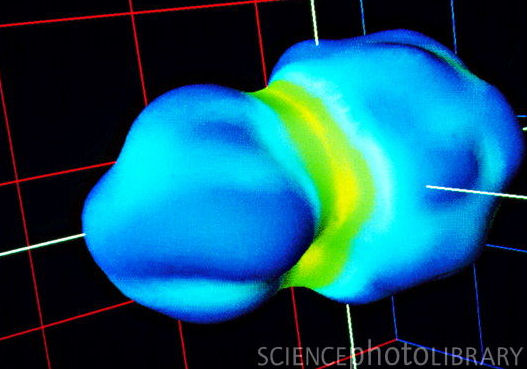 10/17/11 — Does it really take ~2,000
lbs to push two uranium nuclei right up against each other? I'm still not sure I did the
calculation right. Check out my two electrical charge
calculations, show me where I'm wrong, and stop me before I calculate again, please. 10/17/11 — Does it really take ~2,000
lbs to push two uranium nuclei right up against each other? I'm still not sure I did the
calculation right. Check out my two electrical charge
calculations, show me where I'm wrong, and stop me before I calculate again, please.
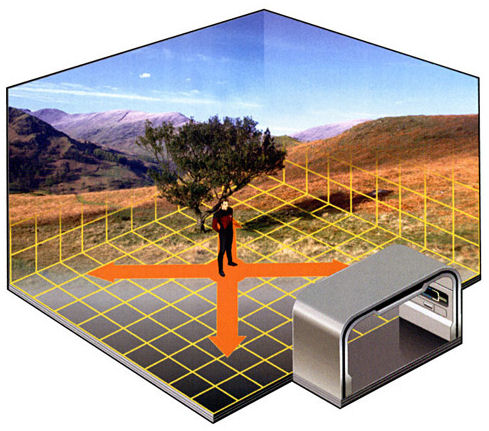 9/10/11 — "Photons
and Electrons: A Speculation on the Material Basis of Consciousness, Inspired by Mr.
Feynman and Captain Picard's Holodeck Horse. What happens on the
holodeck stays on the holodeck. – Anon 9/10/11 — "Photons
and Electrons: A Speculation on the Material Basis of Consciousness, Inspired by Mr.
Feynman and Captain Picard's Holodeck Horse. What happens on the
holodeck stays on the holodeck. – Anon
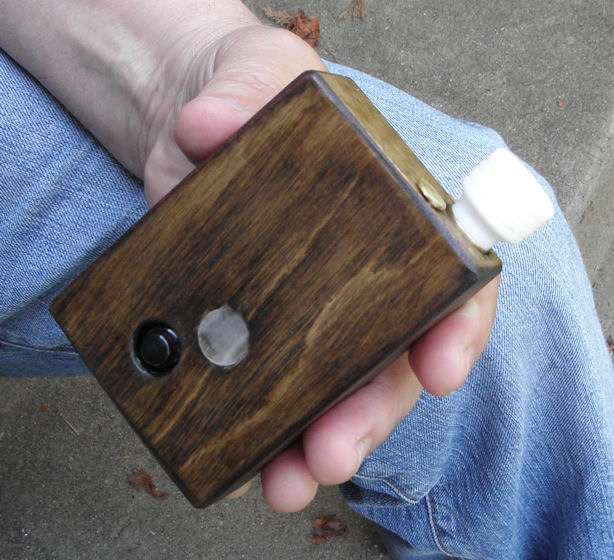 7/15/11 — It looks like I'm still making
vaporizers — if the price is right. Specifically, I'm open to making
Tobacco Master units. Check out
my latest creation. Contact me, Bob, if
you want to talk vapor and means related thereto. 7/15/11 — It looks like I'm still making
vaporizers — if the price is right. Specifically, I'm open to making
Tobacco Master units. Check out
my latest creation. Contact me, Bob, if
you want to talk vapor and means related thereto.
 5/12/11 — A comet heads in toward the sun, then a billion
tons of mass come come flying off a nearly a million miles an hour. Was there
a connection? Probably not, but the videos are worth a few moments of contemplation. 5/12/11 — A comet heads in toward the sun, then a billion
tons of mass come come flying off a nearly a million miles an hour. Was there
a connection? Probably not, but the videos are worth a few moments of contemplation.
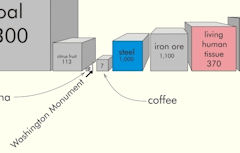 3/14/11 — Terms like "million tons"
and "billion tons" are sometimes mentioned in the news. How much is a million tons of
something? Here are some visual perspectives for Thinking
about Big Things to get a grip on the millions of tons of canned tuna, coal,
corn and other things produced annually by 375 million tons of living human tissue. 3/14/11 — Terms like "million tons"
and "billion tons" are sometimes mentioned in the news. How much is a million tons of
something? Here are some visual perspectives for Thinking
about Big Things to get a grip on the millions of tons of canned tuna, coal,
corn and other things produced annually by 375 million tons of living human tissue.
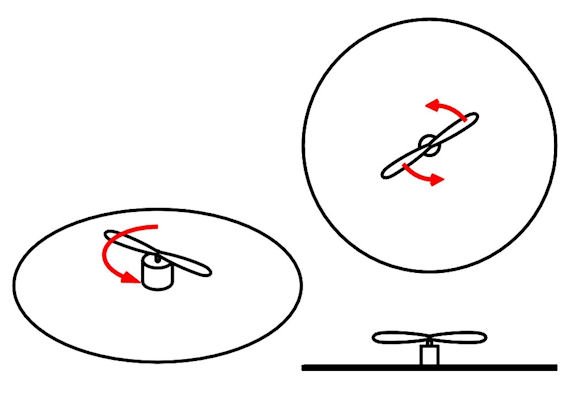 3/7/11 — Latest
Project — Vertical Lift. This is a diagram of what I thought was a great
idea, when I was 11 years old in 1953, and flying saucers were hot items in the news.
Anyone with the slightest knowledge of aerodynamics and Newton's Third Law of Motion
should see the silliness of the thing. 3/7/11 — Latest
Project — Vertical Lift. This is a diagram of what I thought was a great
idea, when I was 11 years old in 1953, and flying saucers were hot items in the news.
Anyone with the slightest knowledge of aerodynamics and Newton's Third Law of Motion
should see the silliness of the thing.

3/7/11 — APOD
Solar Flare for today.

2/28/11 — Need Money? Check out this proven, free, money-making
idea.
 2/26/11 — Uncle Harry's good friend
Bill explains Barney Frank's scheme to "transfer wealth"
by giving mortgages to poor people who have no hope of paying them off. 2/26/11 — Uncle Harry's good friend
Bill explains Barney Frank's scheme to "transfer wealth"
by giving mortgages to poor people who have no hope of paying them off.
 2/25/11 — A correspondent whose name is Jesse says he believes
the idea global warming is fiction. He wrote to ask if I believe in it. I said no, the
idea of Global Warming is Unbelievable — but 'tis plausible. 2/25/11 — A correspondent whose name is Jesse says he believes
the idea global warming is fiction. He wrote to ask if I believe in it. I said no, the
idea of Global Warming is Unbelievable — but 'tis plausible.
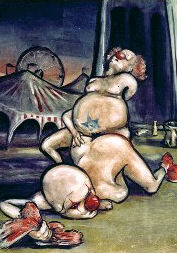
2/24/11 — God's Sex Joke
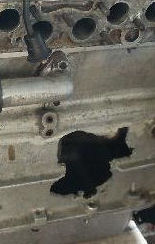 2/22/11 — A Pneuma owner and long-time correspondent asked if I'd ever
experienced a thrown connecting rod in a car engine. Here's my write-up on a
Thrown Rod, which will I hope provoke me to
describe how ol' buddy Ron patched up his 1951 BSA Goldstar in Chapala, Mexico, when
his piston disintegrated when we were there in the summer of 1964. There's also a
link to a neat video of motorcycle accidents. 2/22/11 — A Pneuma owner and long-time correspondent asked if I'd ever
experienced a thrown connecting rod in a car engine. Here's my write-up on a
Thrown Rod, which will I hope provoke me to
describe how ol' buddy Ron patched up his 1951 BSA Goldstar in Chapala, Mexico, when
his piston disintegrated when we were there in the summer of 1964. There's also a
link to a neat video of motorcycle accidents.
 2/22/11 — The New Yorker's image of what an in-coming
asteroid would look like (February 28 issue) is different from the one I have
in my thoughts on certain details of an asteroidal impact. 2/22/11 — The New Yorker's image of what an in-coming
asteroid would look like (February 28 issue) is different from the one I have
in my thoughts on certain details of an asteroidal impact.
 2/17/11 — Most fossils we see
represent the remains of plants or animals. But some fossils are different, such
as the 3.5-million year old Laetoli
footprints of ancient humans. I found an Unusual
Fossil near Hancock, Maryland, some years ago. Took me a few minutes to
figure out what it was. Others might see what it is immediately. 2/17/11 — Most fossils we see
represent the remains of plants or animals. But some fossils are different, such
as the 3.5-million year old Laetoli
footprints of ancient humans. I found an Unusual
Fossil near Hancock, Maryland, some years ago. Took me a few minutes to
figure out what it was. Others might see what it is immediately.
2/16/11 — Slow-Motion view of Saturn V Liftoff
 2/13/11 — Within the past year or so
it became clear that if a person presents something to the public, some personal creation
such as, say, Andy Warhol's art or the movies of Tom Cruise or John Travolta,
A Lot of People will like it and want more.
A comment on two articles. 2/13/11 — Within the past year or so
it became clear that if a person presents something to the public, some personal creation
such as, say, Andy Warhol's art or the movies of Tom Cruise or John Travolta,
A Lot of People will like it and want more.
A comment on two articles.
2/8/11 — Uncle Harry and the Big Picture
 1/29/11 — Fear,
Terror & Marijuana — The word "fear" in the title of today's
comment refers to the "uneasiness" I feel when I use marijuana. 1/29/11 — Fear,
Terror & Marijuana — The word "fear" in the title of today's
comment refers to the "uneasiness" I feel when I use marijuana.
1/26/11 — Fast Brains
12/24/10 — A Comment of Portable Vaporizers
9/15/10 — I didn't learn to read till I was 31. What's funny, sort of, was
that, by then, I had got a degree in mechanical engineering and taught AP math and
physics. Marijuana was involved in learning to read. Check out my write-up on
Marijuana and Reading.
Contact me, Bob, if you
have a comment or question.
|
| |